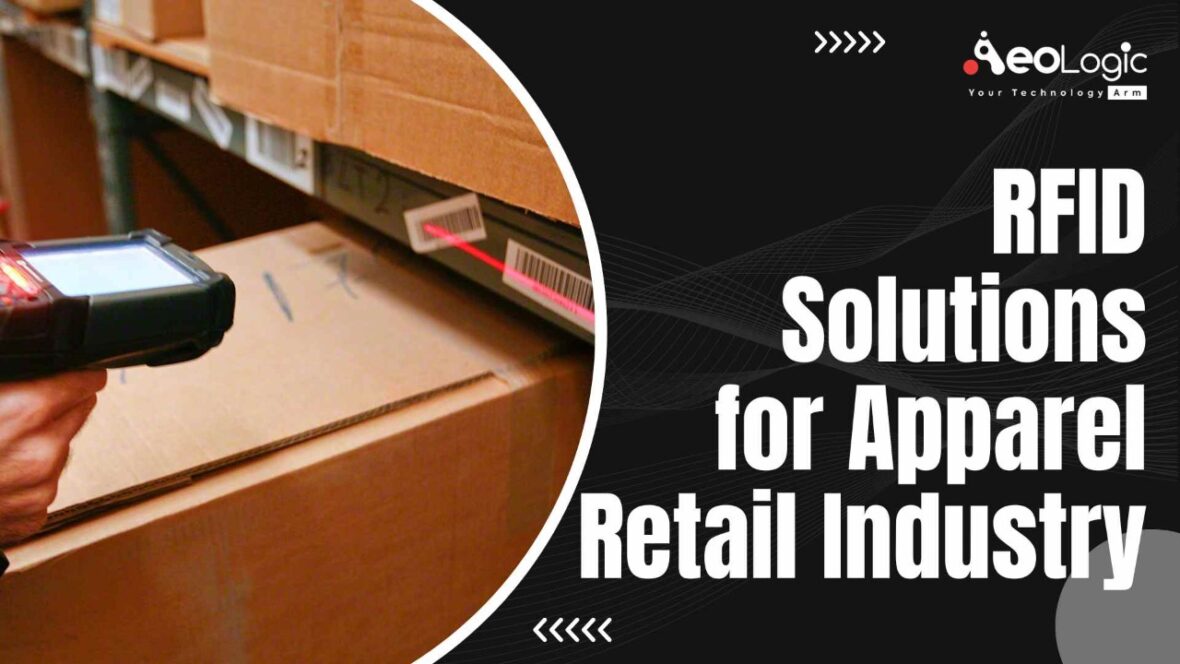Implementing an RFID solution in apparel retail is a great way to increase the efficiency and profitability of your business. In this article, we will discuss the basics of RFID solutions for apparel retail industry and how it can help retailers like you.
Every industry is looking for ways to better protect their intellectual property, reduce the margin of error, and increase productivity. However, these benefits can be difficult to come by when faced with the challenges of RFID tags that are hard to read, incompatible with existing systems, or simply do not work. Find out how one company is overcoming those challenges and why this is just the beginning!
Let’s begin!
Table of contents
- Introduction to RFID
- Experts Agree There is Strong Success for RFID in Retail Apparel
- RFID Solutions for Apparel Retail Industry
- Benefits of RFID Solutions
- RFID Tags and Labels
- How RFID Is Used in the Apparel Industry
- Challenges of Applying RFID in the Apparel Industry
- How to Implement an RFID Solution in Apparel Retail
- Conclusion
Introduction to RFID
RFID, or Radio Frequency Identification, is a technology that uses radio waves to identify and track objects. RFID has been around for over 50 years, but it’s only in the last few years that the technology has become widely used in retail applications.
RFID tags are tiny chips that contain a unique identifier and can be attached to products or packaging. When an RFID tag is scanned by an RFID reader, the unique identifier is transmitted and can be used to track the product throughout the supply chain.
RFID tags offer a number of advantages over traditional barcodes. They can be read at a distance, so products don’t need to be individually scanned. They’re also more durable than barcodes, so they can withstand the rigors of the retail environment. And because each RFID tag has a unique identifier, retailers can use them for product authentication and tracking individual items.
RFID solutions are being used in a variety of ways in the apparel retail industry. Retailers are using RFID tags to track inventory levels and product locations in real time. This helps them to keep better control over their inventory and reduces out-of-stock.
Also Read: 10 Ways to Use Artificial Intelligence to Improve Business Processes
Experts Agree There is Strong Success for RFID in Retail Apparel
There is strong success for RFID in retail apparel, according to experts.
The use of RFID technology in retail apparel has been a hot topic since the start of this year, and it’s not slowing down. In fact, many experts believe that technology will be a key part of retail apparel going forward, according to a recent survey by the Retail Industry Leaders Association (RILA).
The survey asked 1,000 sales and operations managers about their plans for RFID in 2018 and 2019. Here are some highlights:
- More than half (54%) plan to implement RFID technology within the next 12 months.
- Nearly three-quarters of respondents said they expect their customers will be able to use mobile apps (81%) or kiosks (76%) as part of their experience.
- Approximately one-third (32%) expect their customers will be able to use digital displays inside stores to make purchases via digital wallets.
RFID Solutions for Apparel Retail Industry
Apparel retailers have a lot of problems to deal with. Besides the fact that the market is highly competitive and the industry is going through a period of tremendous change, there are also other external factors that affect how they operate. The constant introduction of new products from different brands and designers means that inventory management has never been more important than it is now – but what can retailers do when they don’t always have enough physical space to store every single piece of clothing they’re handling?
Benefits of RFID Solutions
The use of RFID solutions in the apparel retail industry can provide many benefits to retailers. By tracking inventory with RFID tags, retailers can reduce stock-outs, improve customer service, and better manage their overall inventory. In addition, RFID solutions can help to improve store security and prevent theft. Overall, the use of RFID solutions can help to improve the efficiency and profitability of apparel retail businesses.
Also Read: The Role of AI in Education And Learning: Just Promises Or Revolution
RFID Tags and Labels
RFID tags and labels are becoming increasingly popular in the apparel retail industry. It stands for “radio frequency identification,” and these tags use radio waves to transmit data. This data can include everything from the item’s price and SKU number to its location in the store.
RFID tags and labels offer a number of benefits for retailers. Perhaps most importantly, they can help to increase accuracy in inventory management. This is because RFID tags can be read automatically, without the need for a human to scan each individual tag or label. This can lead to substantial time and cost savings.
In addition, RFID tags can help to deter theft and fraud. This is because the data transmitted by the tag can be used to track the movement of an item throughout the store. If an item is stolen or tampered with, retailers can quickly identify where it was last located.
Overall, RFID tags and labels offer a number of advantages for apparel retailers. They can help to improve inventory management, deter theft and fraud, and save time and money.
Also Read: Why Is CRM Software a Game-changer When It Comes to Delivering Better Customer Experiences?
How RFID Is Used in the Apparel Industry
Radio frequency identification, or RFID, is a type of technology that uses radio waves to track and identify objects. This can be done either through active or passive means. Active RFID uses tags that are powered by a battery, while passive RFID tags rely on the power emitted by the reader to function.
RFID has many applications in the retail industry, but it is especially useful in the apparel industry. Apparel retailers can use RFID to track inventory levels, keep track of items that need to be reordered, and even prevent theft.
One of the biggest benefits of RFID for apparel retailers is its ability to streamline the inventory process. In the past, retailers would have to physically count each item of clothing in their store to know what needed to be restocked. With RFID, retailers can simply scan their inventory with a handheld device and get an accurate count of what is on hand. This not only saves time but also reduces the chances of human error.
Another way that RFID can help apparel retailers is by preventing theft. Retailers can attach RFID tags to clothing items and then use security gates at exits to detect any items that have not been properly paid for.
Read: The Role of AI in Education And Learning: Just Promises Or Revolution
Challenges of Applying RFID in the Apparel Industry
The apparel industry is one of the most competitive industries in the world. In order to stay ahead of the curve, retailers must continually look for ways to improve their operations and increase efficiency. One technology that has been gaining attention as a potential solution for the apparel industry is RFID (radio frequency identification).
RFID has already been successfully implemented in other industries, such as the automotive and retail sectors. However, there are unique challenges that come with applying RFID to the apparel industry. In this blog post, we will explore some of these challenges and discuss how they can be overcome.
One of the biggest challenges faced when implementing RFID in the apparel industry is the wide variety of SKUs (stock-keeping units) that must be managed. Apparel items come in all shapes and sizes, which makes it difficult to standardize tags and tracking systems. In addition, many apparel items are made from materials that can interfere with RFID signals, such as metal or leather. As a result, specialized tags and readers must be used in order to get accurate readings.
Another challenge faced when using RFID in the apparel industry is the potential for false positives. This occurs when an RFID tag is read but no corresponding item is present. This can be problematic when items are mistagged or just lost in the store. With RFID, many people are concerned about the privacy and security of their information, and they worry that the RFID tags will be used to track customer movements.
In spite of these challenges, retailers have begun implementing RFID in some areas of the apparel industry. There are a number of reasons why it makes sense for retailers to use RFID in the apparel industry.
How to Implement an RFID Solution in Apparel Retail
Implementing an RFID solution in apparel retail is not as difficult as you might think. The key is to start small, as a small investment of time and money can reap big benefits.
1. Purchase an RFID reader from your local electronics store or online retailer. The reader will cost between $50-$100 and should last for years if taken care of properly.
2. Get a clear plastic case for your reader with a cutout for the antenna that is about 1/4 inch wider than the reading area (the larger the area where you want to read tags, the smaller the cutout). This case also serves as a protective cover when not in use.
3. Purchase some stickers or labels from a printing company that can be printed with your logo or brand name on them (these are sometimes referred to as “smart labels”). These stickers should be placed on each item that needs to be tagged before they leave the store so that employees will know where they need to scan their items before putting them into storage or shipping them out to customers.
4. Purchase a handheld scanner that can read the tags on your items, or purchase one of the scanners made specifically for RFID cases (these are often called “tag readers”). You can attach them to your smartphone or tablet with an app that lets you scan items as they come through the store. This will let you keep track of all your inventory, and make it easier for employees to find items that are missing or have been misplaced.
5. Purchase RFID tags that can be placed on the cases of your products so that they can be automatically identified by the handheld scanner or tag readers when they pass through your store.
Conclusion
The advent of RFID technology has been revolutionary for the retail clothing business, drastically cutting down on the amount of time spent on inventory and limiting the occurrence of inventory-related issues. RFID’s adaptability in the retail industry is sufficient to persuade the clothes retail industry that adopting the technology is an essential next stage in the industry’s evolution.
The RFID solutions for apparel retail industry are many and varied. With the right solution in place, retailers can benefit from increased accuracy in inventory management, faster checkout times, and improved customer service. However, it is important to select the right solution for your specific needs. We hope that this article has helped you narrow down the options and find the perfect RFID solution for your business.
You may quickly expand your company using the RFID Solution. Ask for a free trial of Aeologic’s software and see how RFID, the best option, can help your company expand.
Aeologic is a great place to start!
Related Blogs:
- How AI/ML Can Change the Public Transportation Industry
- Transforming Business With Digital Technology in the Oil Palm Industry in India
- Importance of Digital Asset Management in the Retail Industry
- How AI is Transforming the Agriculture Industry
- 10 Ways to Use Artificial Intelligence to Improve Business Processes
- The Future of IoT Technology in Convenience Stores
- Building Manufacturing Resilience Through AI and ML






